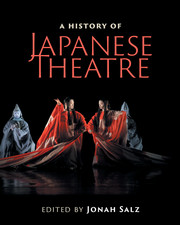Book contents
- Frontmatter
- Contents
- List of figures
- List of tables
- Contributors
- Contributors’ biographies
- Foreword
- Acknowledgments
- Note on Japanese terms
- List of abbreviations
- Timeline
- Editor's introduction
- I Traditional theatres
- Preface to Part I Japanese civilization arises
- II Modern theatres
- Preface to Part II
- 6 Birth of modern theatre: shimpa and shingeki
- Interlude Modern comedies and early musicals
- Interlude Takarazuka: all-girls’ revue and musicals
- 7 Rise of shingeki: Western-style theatre
- Interlude Manzai and Yoshimoto vaudeville comedy
- 8 Wartime colonial and traditional theatre
- Interlude Kami-shibai: picture-card storytelling
- 9 Maturing shingeki theatre
- Interlude Postwar musicals and commercial theatre
- 10 Sixties Theatre
- Interlude Butoh: dance of darkness and light
- 11 Contemporary theatre
- Interlude Tokyo: world theatre capital
- Interlude Charting Tokyo theatre today: 24 November 2012
- Interlude Modern theatre tomorrow: interview with Oriza Hirata
- III Arcs and patterns
- IV Theatre architecture
- Preface to Part IV Evolution of Japanese theatre architecture
- V Theatre criticism
- VI Intercultural influences
- Epilogue: Frozen words and mythology
- Further reading
- Index
- References
7 - Rise of shingeki: Western-style theatre
from Preface to Part II
Published online by Cambridge University Press: 05 July 2016
- Frontmatter
- Contents
- List of figures
- List of tables
- Contributors
- Contributors’ biographies
- Foreword
- Acknowledgments
- Note on Japanese terms
- List of abbreviations
- Timeline
- Editor's introduction
- I Traditional theatres
- Preface to Part I Japanese civilization arises
- II Modern theatres
- Preface to Part II
- 6 Birth of modern theatre: shimpa and shingeki
- Interlude Modern comedies and early musicals
- Interlude Takarazuka: all-girls’ revue and musicals
- 7 Rise of shingeki: Western-style theatre
- Interlude Manzai and Yoshimoto vaudeville comedy
- 8 Wartime colonial and traditional theatre
- Interlude Kami-shibai: picture-card storytelling
- 9 Maturing shingeki theatre
- Interlude Postwar musicals and commercial theatre
- 10 Sixties Theatre
- Interlude Butoh: dance of darkness and light
- 11 Contemporary theatre
- Interlude Tokyo: world theatre capital
- Interlude Charting Tokyo theatre today: 24 November 2012
- Interlude Modern theatre tomorrow: interview with Oriza Hirata
- III Arcs and patterns
- IV Theatre architecture
- Preface to Part IV Evolution of Japanese theatre architecture
- V Theatre criticism
- VI Intercultural influences
- Epilogue: Frozen words and mythology
- Further reading
- Index
- References
Summary
Shingeki had its heyday from around 1929 to the end of World War II. By 1929, the spotlight of modern Japanese theatre had already shifted from pioneering artistic expressions of Tsukiji Shōgekijō to proletarian theatre. Inspired by Marxist ideals to fight for the working majority instead of entertaining only the intellectual few, proletarian theatre artists produced pieces that strongly influenced the audience, turning shingeki into a school about capitalism. This provoked government suppressions, which led to political apostasy by shingeki leaders, while a separate group of artists pursued apolitical shingeki.
The split of Tsukiji Shōgekijō
As Powell notes in the preceding chapter, the pioneering Tsukiji Shōgekijō company split into two troupes in March 1929. Several factors can be identified as immediate causes. Co-founders Osanai Kaoru and Hijikata Yoshi had conflicting artistic visions for the company, with Osanai aiming at pre-Revolution Stanislavski-style realism, while Hijikata targeted more innovative approaches to theatre including Expressionism and those of Meyerhold. Meanwhile, financially, the company faced difficulties for most of its existence. Each time a deficit was incurred, Hijikata would cover the loss personally. Hijikata's position as co-founder and his constant financial sacrifice made sympathetic company members find it unfair of the majority to try to expel him.
Politics had played a decisive role in the shingeki movement's orientation, from before the split to the postwar period. As early as January 1926, actor Senda Koreya (1904–94) resigned from the company because he could not bear its art for art's sake orientation, a clear sign of Marxist influence. His political consciousness was awakened in the aftermath of the Great Kantō Earthquake in September 1923, which killed over 100,000 in fires, tsunami, and landslides. In the wake of this devastation, anti-Korean sentiment and rumors fueled violent mobs and police to attack Koreans as saboteurs. Senda was taken to be a Korean provocateur near Sendagaya Station in Tokyo, and almost killed. This incident prompted him to take a lifelong critical stance against authoritarianism and assume his professional name, homonymous to “Sendagaya Korean.”
Other members, including Kubo Sakae (1900–58) and Susukida Kenji (1898–1972), were also attracted to Marxism. They formed the Young Tsukiji School (Seinen Tsukiji-ha), a secret study group, and even tried to stage a play of their own selection.
- Type
- Chapter
- Information
- A History of Japanese Theatre , pp. 234 - 247Publisher: Cambridge University PressPrint publication year: 2016

